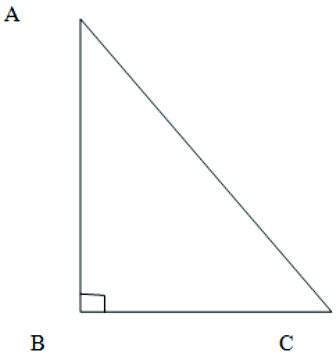7.5 SOME INEQUALITIES IN A TRIANGLE:
* A triangle in which all three sides are different is called a scalene triangle.
Exercise 7.4
- Show that in a right angled triangle, the hypotenuse is the longest side.

Given : ∠B = 900
To Prove: AC > BC and AC > AB
Proof: In Δ ABC we get ∠A + ∠B + ∠C = 1800 (angles of a triangle) ∠A + 900 + ∠C = 1800 ( B = 900) ∠A + ∠C =180°− 90° = 900
i.e. ∠A + ∠C = B and so we get B > C and B > A Side opposite to B is AC and Side opposite to C is AB Side opposite to A is BC ∴ ∴ AC > BC and AC > AB AC is the longest side and AC is also the hypotenuse ∴ ∴ The hypotenuse is the longest side.
2. In Fig. 7.48, sides AB and AC of ABC are extended to points P and Q respectively. Also, PBC < QCB. Show that AC >AB.
Given: ∠PBC < ∠QCB To prove : AC > AB Proof: ∠PBC + ∠ABC = 1800 — (1) ∠QCB + ∠ACB = 1800 —— (2)  (both are linear pairs) From (1) and (2) we get ∠PBC + ∠ABC = ∠QCB + ∠ACB But ∠PBC < ∠QCB (given) ∠ABC > ∠ACB Side opposite to ABC is AC Side opposite to ACB is AB AC > AB
(both are linear pairs) From (1) and (2) we get ∠PBC + ∠ABC = ∠QCB + ∠ACB But ∠PBC < ∠QCB (given) ∠ABC > ∠ACB Side opposite to ABC is AC Side opposite to ACB is AB AC > AB
3. In Fig. 7.49, B < A and C < D. Show that AD<BC.

Given: B < A and C To prove: AD < BCProof: B < A (given) ∴ A > B
Side opposite A is OB Side opposite B is OA AB >OA ——–(1) In the same way OC > OD ———–(2) From (1) and (2) we get [OB+ OC ] > [OA + OD] BC > AD i.e. AD < BC
4. AB and CD are respectively the smallest and longest sides of a quadrilateral ABCD (see Fig. 7.50). Show that A > C and B> D.
 Solution:
Solution:
Given: AB is smallest side
And CD is longest side
To prove: A > C and B > D
Const: Join AC
Proof: In ABC we get
BC > AB ( AB is smallest side)
Angle opposite to BC is BAC
Angle opposite to AB is BCA
BAC> BCA —————–(1)
In ACD we get
CD > AD (CD is the longest side)
Angle opposite to CD is CAD
Angle opposite to AD is ACD
CAD > ACD —————–(2)
Adding (1) and (2) we get
BAC + CAD = BCA + ACD
A > C
By joining BD we will get B > D
- In Fig.7.51, PR >PQ and PS bisects QPR. Prove that PSR > PSQ.

Solution:
Given: PR > PQ and PS bisects QPR means QPS = RPS
To prove: PSR > PSQ
Proof:
QPS = RPS (PS bisects QPR) (given) ——(1)
PR > PQ (given)
Angle opposite to PR is PQS
Angle opposite to PQ is PRS
PQS > PRS —————— (2)
Adding (1) and (2) we get
( PQS + QPS) > ( PRS + RPS)
We know that in triangles the exterior angle is equal to
the sum of the interior opposite angles)
PSR = PQS + QPS
And PSQ = PRS + RPS
From above we get
PSR > PSQ
- Show that of all line segments drawn from a given point not on it, the perpendicular line segment in the shortest.

Solution:
Given: PQ, PR and PS are line segments
To prove: PQ is the shortest line segment
Proof: PQ is the perpendicular on line QS and
PR and PS are any other two line segments
We know that in a triangle if one angle is 900
Then the other angles have to be lesser than 900
Here for perpendicular PQ we get
PQR > PRQ (for PQR)
Also PQR > PSQ (for PSR)
PR > PQ and PS > PQ
PQ is the shortest line segment
The perpendicular line segment is the shortest

